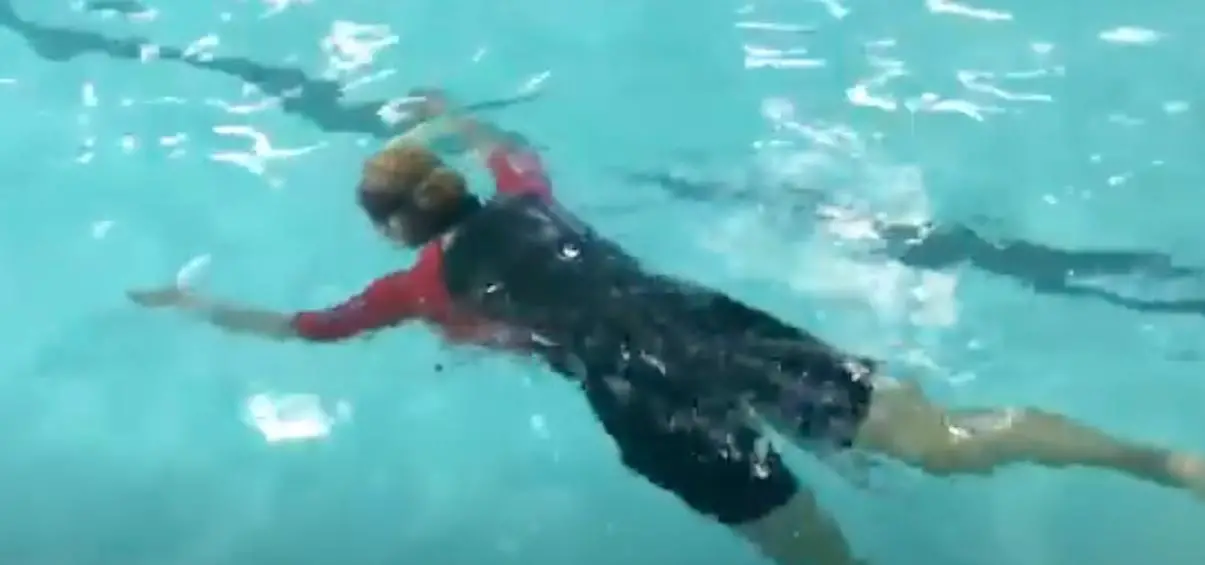A wetsuit is a piece of clothing designed to keep you warm in water. They are made of neoprene, which is a type of synthetic rubber. Wetsuits work by trapping a layer of water between your body and the suit. Your body heat then warms up this layer of water, keeping you comfortable in cold conditions.
So does a wetsuit make you float? The short answer is yes, it does – but not as much as a life jacket. They might assist in flotation, but do not outright provide it. Whatever activity you use a wetsuit for, they’ll help you float – and keep you warm while doing it.
Wetsuits are popular among swimmers, surfers, and divers because they allow them to stay in cold waters for longer periods of time without getting hypothermia. They also provide some buoyancy, which can be helpful if you’re swimming in rough waters or trying to tread water for an extended period of time. However, life jackets will always provide more flotation than a wetsuit alone.
If you’re considering using a wetsuit for any aquatic activities, remember that they will help you float – but don’t rely on them to keep you afloat entirely. Make sure to wear a life jacket as well for maximum safety.
1. What is a wetsuit?
A wetsuit is a waterproof garment typically worn by surfers, divers, and other water sports enthusiasts. Thewetsuit keeps the wearer’s body warm by trapping a thin layer of water between the skin and the fabric of the suit. Wetsuits are made from neoprene, a synthetic rubber material that is both insulating and flexible.
Wearing a wetsuit can make a big difference in comfort while surfing or diving in cold water. It is important to choose a wetsuit that fits properly in order to maximize its insulation properties. A well-fitting wetsuit will be snug but not too tight, and it should allow for full range of motion.
There are different types of wetsuits available depending on the activity you’ll be doing and the temperature of the water you’ll be swimming in. For example, thinner suits with less insulation are typically worn in warmer waters, while thicker suits with more insulation are better suited for colder temperatures.
2. How do wetsuits work?
Wetsuits work by trapping a thin layer of water between your body and the suit. This layer of water is warmed by your body which prevents you from losing too much heat while in the water. Water molecules conduct energy (heat) 25-40 times faster compared to air molecules.
The neoprene material that wetsuits are made out of has tiny pockets of air within it. These pockets of air provide insulation to keep you warm. When you first jump into the water, these pockets of air quickly fill up with water and squeeze out, which is why wetsuits feel tight at first. But once you’re in the water for awhile, the neoprene will loosen up and conform to your body shape better.
3. Do wetsuits make you float?
A wetsuit is a garment, usually made of foamed neoprene, which is worn by surfers, divers, windsurfers, canoeists and others engaged in water sports. The main purpose of a wetsuit is to insulate the body from cold water and provide some degree of buoyancy.
So does a wetsuit make you float? The short answer is yes, it does – but not as much as a life jacket. They might assist in flotation, but do not outright provide it. Whatever activity you use a wetsuit for, they’ll help you float – and keep you warm while doing it.
Wetsuits work by trapping a layer of water between the skin and the suit itself. Body heat then warms this layer of water, providing insulation against the colder water outside. This trapped layer of water also provides some buoyancy, helping the wearer to float.
However, because wetsuits are designed to trap a layer of water next to the skin, they can cause dehydration if worn for too long. It’s important to drink plenty of fluids before and after wearing a wetsuit, especially in hot weather conditions.
4. Why are wetsuits popular among swimmers, surfers, and divers?
Wetsuits are popular among swimmers, divers, and surfers for a few reasons. First, wetsuits help insulate the body and retain heat. This is important in cold water conditions where hypothermia is a risk. Wearing a wetsuit can help prevent hypothermia by keeping the body warm. Second, wetsuits provide some protection from the elements. When surfing or diving in rough waters, a wetsuit can help protect the skin from scrapes and cuts. Finally, wetsuits can simply be more comfortable to wear than other types of clothing when participating in water activities.
5. What are the benefits of using a wetsuit?
A wetsuit is a type of clothing typically worn by swimmers, divers, or surfers who swim in cold water. Wetsuits work by insulating the wearer’s body, helping to retain body heat. This can help prevent hypothermia, a condition where the body temperature drops to dangerously low levels.
Wetsuits are usually made from a material called neoprene, which is a type of rubber. Neoprene is an excellent insulator and helps to keep the wearer’s body warm even in very cold water temperatures. Wetsuits come in different thicknesses depending on how much insulation they need to provide.
There are many benefits to wearing a wetsuit while swimming or surfing in cold water. Wetsuits help protect against hypothermia and can also increase your buoyancy, making it easier to float and stay afloat in the water. They can also provide some protection from stings and scratches from rocks or other underwater obstructions.
6. Are there any drawbacks to using a wetsuit?
There are a few potential drawbacks to using a wetsuit. First, they can be quite tight and constricting, which can make it difficult to move around or swim freely. Additionally, if the water is particularly cold, a wetsuit may not provide enough insulation to keep you warm. Finally, wetsuits can be expensive, so if you’re only going to use one occasionally, it might not be worth the investment.
7. How can you use a wetsuit safely?
A wetsuit is a piece of clothing designed to keep you warm in water. Wearing a wetsuit can help prevent hypothermia, which is when your body loses heat faster than it can produce it.
There are some things you should keep in mind when using a wetsuit:
-Wear a wetsuit that fits properly. A loose wetsuit will allow cold water to seep in and will not be as effective at keeping you warm. Conversely, a wetusit that is too tight can restrict your movement and make it difficult to breathe. -Put on the wetusit slowly and carefully. Avoid putting the wetusit on over any jewelry or other sharp objects that could puncture it. -Be aware of how long you plan to stay in the water. If you are going to be in the water for an extended period of time, make sure to take breaks every so often to warm up and avoid getting too cold.

FAQs
Do you float better in a wetsuit?
A wetsuit is a piece of clothing designed to insulate your body and help you float in water. The material used in a wetsuit, neoprene, is buoyant and creates less drag than other materials. This means that you can swim faster while wearing a wetsuit. However, it is important to choose the right size wetsuit. If it feels like a second layer of skin, it will be more comfortable and effective at helping you float.
Can you sink in a wet suit?
A wet suit is a garment that is typically worn by people who are engaged in water-based activities, such as swimming, surfing, or scuba diving. The wet suit is designed to insulate the body and provide buoyancy.
While a wet suit will not outright prevent someone from sinking, it can certainly assist in flotation. This is because the material of a wet suit is less dense than water, meaning that it will displace more water and therefore provide more buoyancy. Additionally, the air trapped in the fabric of a wet suit will also help to provide some degree of floatation.
However, it is important to keep in mind that a wet suit does not provide the same level of buoyancy as a life jacket. So if you are planning on participating in any activity where there is a risk of drowning, it is always best to wear a life jacket for added safety.
Does wetsuit help you float?
A wetsuit is a garment made of neoprene, which is a type of synthetic rubber. It’s usually worn by divers, surfers, and other people who spend time in the water. The neoprene material used in a wetsuit helps to insulate the body and retains body heat. This makes it ideal for cold-water activities.
But does a wetsuit actually make you float? The short answer is yes, it does – but not as much as a life jacket. They might assist in flotation, but do not outright provide it. Whatever activity you use a wetsuit for, they’ll help you float – and keep you warm while doing it.
Wetuits work by trapping small pockets of air against your skin. This trapped air acts as an insulator against the colder water temperatures and also provides some buoyancy. However, because wetuits are made of relatively thin material, they don’t provide as much buoyancy as something like a life jacket or personal flotation device (PFD).
So if you’re looking to stay afloat in the water – whether for recreation or survival – a wet suit alone may not be enough. A life jacket should always be worn over top of your wet suit to provide additional buoyancy and peace of mind.
Are neoprene wetsuits buoyant?
A neoprene wetsuit is a type of wetsuit made from neoprene, a synthetic rubber. Neoprene is known for its buoyancy, which makes it ideal for use in water sports and activities. Neoprene wetsuits are popular among swimmers, surfers, and divers because they provide extra floatation and support in the water.
Most neoprene wetsuits are designed to be form-fitting and comfortable to wear. They typically have a zip closure or Velcro fasteners at the front or back, and may also include pockets for storage. Some neoprene wetsuits also feature built-in flotation devices such as foam inserts or air bladders to help keep the wearer afloat in case of an emergency.
Neoprene wetsuits are available in a variety of styles depending on the activity they will be used for. Shorty wetsuits only cover the torso and legs, while full suitwet suits extend down to the feet and wrists. There are also specialized types of neoprene wet suits designed specifically for surfing, diving, kayaking, canoeing, windsurfing, kitesurfing, wakeboarding, jetskiing, and other water sports.




